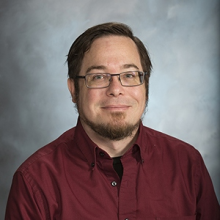-
Title
Staff Scientist -
Email
classen2@llnl.gov -
Phone
(925) 422-0268 -
Organization
Not Available
Research Interests
Tim Classen is a staff scientist at LLNL in the Rare Event Detection group. Dr. Classen's primary research interests reside in antineutrino detection, both for fundamental physics measurements, as well as development of antineutrino detection for nuclear safeguards. He has a long history in experimental neutrino physics including KamLAND and Double Chooz, and is currently a member of the PROSPECT experiment.
In addition, as part of the NIFFTE collaboration, Dr. Classen works towards improving nuclear data measurements. He also works to adapt detector technology for national security applications, particularly for neutron detection and spectroscopy applications.
Ph.D., Physics, University of Alabama, 2007
M.Sc., Physics, University of Alabama, 2006
B.Sc., Physics, University of Missouri Rolla, 1999
- J. Ashenfelter, et. al. (PROSPECT Collaboration), Measurement of the Antineutrino Spectrum from 235U Fission at HFIR with PROSPECT, submitted to Phys. Rev. Letters; https://arxiv.org/abs/1812.10877
- J. Ashenfelter, et. al. (PROSPECT Collaboration), First search for short-baseline neutrino oscillations at HFIR with PROSPECT, Phys. Rev. Letters 121 (2018) 251802; http://dx.doi.org/10.1103/PhysRevLett.121.251802
- J. Ashenfelter, et. al. (PROSPECT Collaboration), The PROSPECT Reactor Antineutrino Experiment, Nucl.Instrum.Meth. A, 922 (2019) 287; http://dx.doi.org/10.1016/j.nima.2018.12.079
- J. Ashenfelter, et. al. (PROSPECT Collaboration), Performance of a segmented 6Li-loaded liquid scintillator detector for the PROSPECT experiment, JINST 13 (2018) P06023; http://dx.doi.org/10.1088/1748-0221/13/06/P06023
- R. Casperson, et. al. (NIFFTE Collaboration), Measurement of the normalized 238U(n,f)/235U(n,f)cross section ratio from threshold to 30 MeV with the fission Time Projection Chamber, Phys. Rev. C 97 (2018) 034618; http://dx.doi.org/0.1103/PhysRevC.97.034618
- J. Ashenfelter, et. al. (PROSPECT Collaboration), Light Collection and Pulse-Shape Discrimination in Elongated Scintillator Cells for the PROSPECT Reactor Antineutrino Experiment, JINST 10 (2015) P11004; http://dx.doi.org/10.1088/1748-0221/10/11/P11004
- J. Ashenfelter, et. al. (PROSPECT Collaboration), Background Radiation Measurements at High Power Research Reactors, Nucl. Instrum. Meth. A 806 (2016) 401-419; http://dx.doi.org/10.1016/j.nima.2015.10.023
- T. Classen, et. al.,Development of an advanced antineutrino detector for reactor monitoring, Nucl.Instrum.Meth. A, 771 (2015) 139; http://dx.doi.org/10.1016/j.nima.2014.10.022
- Y. Abe, et. al. (Double Chooz Collaboration), Indication of Reactor ve Disappearance in the Double Chooz Experiment, Phys. Rev. Letters 108 (2012) 131801; http://dx.doi.org/10.1103/PhysRevLett.108.131801
- S. Abe, et. al. (KamLAND Collaboration), Precision Measurement of Neutrino Oscillation Parameters with KamLAND, Phys. Rev. Letters 100 (2008) 221803; http://dx.doi.org/10.1103/PhysRevLett.100.221803
- 2019 Director’s Science and Technology Award: First Above Ground Detection of reactor Antineutrinos by the PROSPECT Experiment
- 2018 Physical and Life Sciences Directorate Award for Science and Technology: “First Results from Breakthrough PROSPECT Antineutrino Detector Experiment”
- 2017 Physical and Life Sciences Directorate Award for Science and Technology: “First Fission Cross Section using the FissionTPC”


